BREAKING NEWS! Piasecki X-49A Speedhawk flight tests: Quieter & Faster = No Shoot-Downs
 youtube.com/watch?v=Yu2CwHwxJYA
youtube.com/watch?v=Yu2CwHwxJYA
 slideshare.net/1st_TSG_Airborne/speedhawk-v30
slideshare.net/1st_TSG_Airborne/speedhawk-v30
UPDATED 23 January 2013
Helicopters Must Fly Above 200 MPH to Survive Over Today's Lethal, Non-Linear Battlefields: No-more Business-As-Usual--or be Put Out-of-Business

BREAKING NEWS! Piasecki X-49A Speedhawk flight tests: Quieter & Faster = No Shoot-Downs
 youtube.com/watch?v=Yu2CwHwxJYA
youtube.com/watch?v=Yu2CwHwxJYA
 slideshare.net/1st_TSG_Airborne/speedhawk-v30
slideshare.net/1st_TSG_Airborne/speedhawk-v30
URGENT COMBAT UPDATE: The Day of Reckoning has arrived for Slow, Loud, Conventional Helicopters
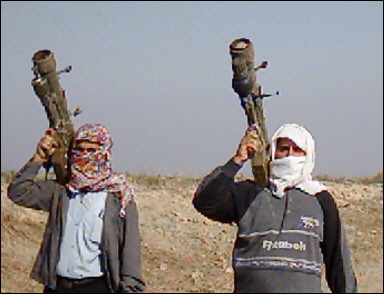
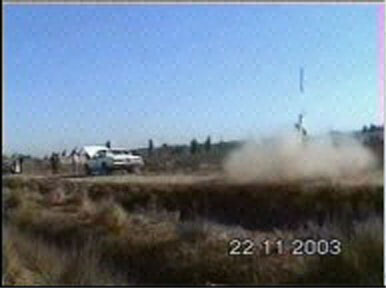
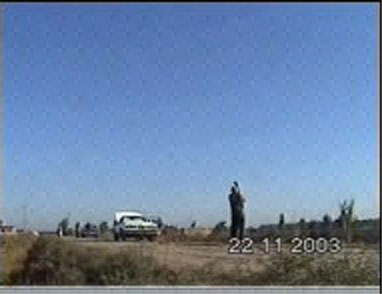

Time to face-the-music.
Not only are our helicopters too hard to maintain and literally grounded except for dire emergencies in Iraq, they fly too slow and too loud to survive enemy MANPADS and small arms-fire. Since some of you will not listen or accept this, so here's two audio/visual "reality checks" from Chechnya:
SA-7 MANPADS vs. Mi-8(?) Hip helicopter
combatreform.org/manpadsvsloudpoorcamohelicopter.wmv
SA-16 MANPADS vs. Mi-26 Halo heavy lift helicopter
combatreform.org/sa16manpadsshootsdownmi26helicopter.wmv
Next, examine our aircraft shoot-down statistics from Iraq:
MILITARYINCOMPETENCE/americaniraqwarcasualties.htm
1. Right off the bat, this should end all debate forever on whether we need fixed-wing observation/attack aircraft. We do. We need to get off our asses and get some.
2. Immediately repaint ALL our helicopters in sky-gray to not help enemy gunners to spot and track and aim on them. The first video shows the fatal flaw of dark green helicopters in a blue sky background.
3. LISTEN to the audio on the first video. Silence our helicopters with NOTAR. If you lose 15% of anti-torque power get bigger engines. That's too fuking bad, anyway. It beats getting shot down and dying, doesn't it? If the two helicopters were in the right camouflage and NOTAR in the first video Mr. Allah Akbar in the bushes may not have even been alerted to go out and fire at them.
The Army should buy the MD520 NOTAR for its 368 x light scout helicopter program not the bullshit, loud and slow Bell 407.
4. Immediately supply EVERYONE on board every fuking U.S. military aircraft bail-out parachutes. In both video shoot downs there was plenty of time and altitude to bail-out and survive the MANPADS strikes. Details:
Why No escape from U.S. Military Aircraft?
5. Immediately start converting our helicopters to Piasecki VTDP/wings so they fly faster at 200 mph to be less vulnerable. This will take some time so there's no excuse why steps 1-4 cannot be taken TODAY.
 youtube.com/watch?v=SyXd9iAak1M
youtube.com/watch?v=SyXd9iAak1M
 Piasecki VTDP detailed coverage starts below.
Piasecki VTDP detailed coverage starts below.
Rotorcraft Report: Piasecki Aircraft wins U.S. Navy contract
by John PersinosGOVERNMENT "EXPERTS" ARE wonderfully reliable contrarian indicators. For example, in 1899, the Director of the U.S. Patent Office, Charles Duell, said: "Everything that can be invented has been invented."
Fortunately, inventors such as Frank Piasecki never subscribe to conventional wisdom. Piasecki, an aviation legend, has, over the years, introduced a host of trail-blazing innovations in rotorcraft design. In particular, he has spent the last four decades doggedly advocating his proprietary technology for compound helicopters. This fall (last year), his efforts achieved a major milestone, with sweeping consequences for the entire industry.

Piasecki Aircraft Corp., Essington, Pennsylvania, was awarded in late October 2000, a $26.1 million four-year U.S. Navy contract for the design, fabrication and flight test of a Vectored Thrust Ducted Propeller (VTDP) compound helicopter.
Address Second Street West, P.O. Box 360, Essington, PA 19029 Founded 1955 Employees 35 Annual revenues $2M Flight facility Essington, PA Owner Private (Frank N. Piasecki) President/CEO Frank N. Piasecki Business dev John Piasecki Phone/fax (610) 521-5700/5935 Website www.piasecki.com Markets USG: 90%, Commercial 5%, Foreign: 5% Products VTDP UH-60 flight demonstrator, Piecework (electromechanical parts), VTOL UAVs The compound helicopter is based on a modified Sikorsky H-60 Hawk family airframe. Sponsored by the Office of Naval Research, the primary objective of this flight demonstration is to show the potential improvements in speed, range, survivability and reduced life cycle costs attainable with Piasecki's VTDP technology.
Computer-Aided Design Simulation The VTDP compound helicopter achieves these goals by adding fixed wings and a tail-mounted ducted propeller. Piasecki Aircraft, founded by Frank Piasecki in 1956, has long proposed this technology as a way to enhance performance and reduce costs of rotorcraft. Today, the company has 50 employees, 20 of them engineers. Starting with Frank's ground-breaking R&D in the early 1960s, the company pioneered the development of compound helicopters. Frank celebrated his 81st birthday in October and still shows up at work, six days a week.continuum-dynamics.com/research/topics/piasecki_research/
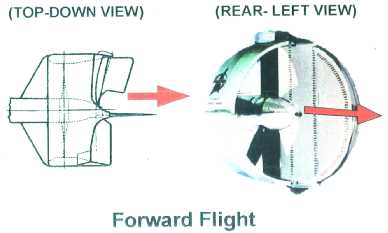
Ducted Fan position for forward flight

Ducted Fan for hovering flight
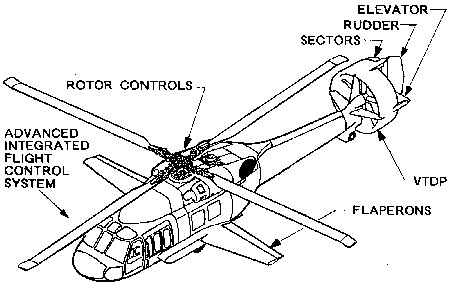
John Piasecki, Frank's son and company vice president, says that the VTDP compound helicopter is capable of faster cruise speeds, longer range, superior maneuverability and reduced costs. The VTDP design augments the aircraft's lift, combating retreating blade stall by unloading the main rotor system as the burden of lift is transferred to the wing. In addition to the stability conferred by the fixed wing, the aircraft reaches greater speeds because of auxiliary propulsion provided by the tail-mounted VTDP, commonly referred to as the "ringtail." The combination of the VTDP and a lifting wing provides for increased speed over 200 knots in production configurations, as well as greater maneuverability and reduced vibration and fatigue loads.
The compound helicopter confers several advantages to the armed forces. One of the most important, in the post-Cold War era of limited military budgets, is lower operating costs. By lowering fatigue loads and vibration levels, the technology can reduce costs and extend the life of parts. The technology also enables a rotary-wing aircraft to fly at up to 220 knots; an attack helicopter fitted with the VTDP system would make for a formidable warship.
John Piasecki says the idea of compound helicopters is coming back into vogue with military planners because of the convergence of limited resources and expanded performance requirements. "This contract traces its origins to early Cold War competitions, but the compound technology is still very relevant, as armed helos proliferate in Third World countries," he says. "Armed helos are versatile and cost-effective aerial weapons platforms. Navy and marines corps aerial assault forces are projected over the sea at greater and greater distances. Emerging military requirements are driving the compound helicopter concept, not the old Fulda Gap scenarios."
The U.S. marines are committed to the V-22 tiltrotor as an aerial assault platform, but they still rely on conventional helicopters, such as the Cobra and Huey. That's where compound technology can make a difference. "Compound helicopter technology could extend the performance and life of these legacy aircraft, to reduce their performance shortfall as compared to the V-22," he says.
Piasecki Aircraft's VTDP was competitively selected by the Navy under the FY00 Advanced Technology Demonstration program, which funds development and testing of high risk/high payoff technologies to address the Navy's future warfighting needs. The contract was awarded after Piasecki successfully completed ground testing of a full-scale flight-worthy VTDP unit under a $16.1 million concept exploration and development contract. John Piasecki says the VTDP Ground Test results were better than predicted, meeting all of the technical criteria necessary to proceed into the flight demonstration phase of the program. The flight test program will be conducted by a Joint Piasecki and Naval Rotary Wing Test Squadron Team, starting in 2003.
The VTDP compound helicopter concept is being investigated as an affordable means of addressing the Defense Department's need to upgrade the capabilities and extend the service life of existing single-rotor helicopters. Based on the services' current aviation modernization plans, the Defense Department is projected to spend over $41 billion to extend the capability and service life of the H-60, H-1, and AH-64 fleets until Joint Replacement Aircraft are fielded sometime after 2025. The Air Force selected the H-60/VTDP compound helicopter concept as one of several alternatives under consideration as an upgrade or replacement for its aging HH-60G combat rescue helicopter fleet. The replacement is slated to be fielded as early as FY07
Model of AH-1W(4BW) VTCAD with PiAC vectored thrust ducted propeller and lifting wings (1996) 
U.S. Army contract to develop a compound helicopter incorporating the Piasecki Vectored Thrust Ducted Propeller (VTDP) concept for the AH-64 Apache and AH-1W SuperCobra is nearing completion. Programme objectives have been met or exceeded by both the AH-64 VTCAD and AH-1W VTCAD configurations, resulting in increased maximum level flight speed to over 200 kt (370 km/h; 230 mph); 50 per cent improvement in longitudinal acceleration and deceleration capability in level flight; 50 per cent decrease in turn and pull-up radii at speeds in excess of 95 kt (176 km/h; 109 mph); and handling qualities that are at least as good as those of the baseline AH-64A Apache and AH-1W.
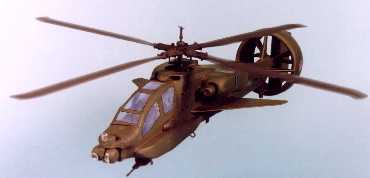
In addition, tactical simulations have confirmed superiority of VTCAD over standard Apache and AH-1W SuperCobra. A separate U.S. Navy contract involves investigation into application of VTDP technology to the AH-1W(4BW) four-blade rotor configuration. The Navy contract also includes ground testing of the full-scale VTDP and additional flight controls simulation and testing of the 4BW/VTDP configuration. Piasecki has also proposed flight demonstration of this technology on an AH-1W(4BW) to the Navy.

Testing Dispute Clouds New Helo
By Stanley W. Kandebo/Aviation Week & Space Technology31-Jul-2002 10:26 AM U.S. EDT
ESSINGTON, PA. -- Piasecki Aircraft Corp. is aiming to demonstrate that modern compound helicopter technology can significantly boost speed, range and handling characteristics of existing rotary-wing aircraft, but differences over flight-clearance requirements are threatening to sideline the program.
Under a $26.1-million advanced technology demonstration contract awarded in October 2000 by the Naval Air Systems Command, the company plans to add a lifting wing with flaperons and a vectored-thrust ducted propeller (VTDP), or "ring tail," to a Navy YSH-60F and demonstrate, in flight, some of the performance benefits the technologies could give existing helicopters.
HOWEVER, DIFFERING VIEWS regarding flight-clearance rules provided by the Navy in April are threatening to make the project more expensive than originally estimated, which could bring down the curtain before the program reaches flight test.
As a result, Piasecki (or PiAC) is discussing a plan with the Navy to conduct flight testing under rules applicable to FAA contractor demonstrations. Taking the FAA route would allow PiAC to execute the project in a rapid prototyping environment, as opposed to the more formal, engineering and manufacturing development flight-clearance process now required by the Navy. The FAA approach, initially raised by the office of the assistant secretary of the Navy for research, development and acquisition, would streamline the effort and make it less expensive, company officials said.
THE BASIC COMPOUND helicopter technology to be added to the SH-60 was first proven in trials of the Piasecki 16H-1 and 16H-1A when the aircraft were flown in the early 1960s at speeds up to 225 mph. Updated versions of that technology are planned for the upcoming tests.
PiAC officials say transforming legacy helicopters already in the fleet into compound helicopters could substantially enhance their performance. First and foremost among the improvements is speed.
Since the wing of a compound helicopter unloads the main rotor, retreating blade stall, which limits most conventional helicopters to forward flight speeds of about 150 kt., does not become an issue in compounds until about 240 kt. Compound speed also is enhanced by Piasecki's thrust-generating ring tail. The original ring tail flown in the 1960s consisted of an aft-facing propeller spinning in the vertical plane to generate thrust, and a system of vertical and horizontal louvers to direct the thrust generated by the propeller. For the upcoming demonstration, PiAC has simplified this technology. The aft-facing variable pitch propeller is still used, but yaw control is provided by a set of nested shells that form a hemisphere around the aft end of the tail when deployed, as well as by a cruciform rudder and horizontal stabilizer mounted within the confines of the tail's duct.
WITH THE RUDDER DEFLECTED to the left (when viewed from behind) and the spherical shells deployed, thrust is deflected to the aircraft's left. When thrust is needed in the opposite direction, the spherical shells are stowed against the wall of the ring tail's duct, and the rudder deflected right. The shells also are retracted during forward flight, with yaw control coming primarily from the rudder. Finite control with the compound helicopter during hover is provided primarily by the pitch of the aft propeller.
PiAC officials say the nested spherical shells have significantly decreased the amount of power needed to generate control torque during hover. "It's about 46% less when compared to the first-generation ring tail," John Piasecki said. He is PiAC's vice president of contracts.
As a measure of the speed enhancement provided by the ring-tail, PiAC officials note that current H-60 aircraft are limited to about 150 kt. in forward flight. But when modified with compound helicopter technology, speeds could increase to 213 kt. for a naval version and to 225 kt. for one configured for Air Force search and rescue.
To gauge the benefits of increased helicopter speeds and agility, Army and marine corps pilots "flew" ring tail-configured Apache and Cobra gunships, respectively, in mock combat during the mid-1990s at Boeing's flight simulation laboratory near Philadelphia. Pilots found that the modified aircraft demonstrated substantial performance, survivability and handling-quality improvements. In fact, the aircraft were able to fly 25% faster and 17% lower than unmodified, baseline helicopters in nap-of-the-earth operations, and were able to engage elevated targets without unmasking.
One marine pilot said the compound version of the AH-1 was tough to beat, in both offensive and defensive air-to-air combat, because of its "significant speed advantage, increased platform stability and the ability to pitch point." According to his written report, the AH-1 can pitch point momentarily, but can't maintain this attitude without losing or gaining airspeed or altitude. The modified, simulated aircraft was able to do so, while hovering, with the nose as much as 21 deg. up or 10 deg. down.
Army pilots also liked the pitch-point capability in the AH-64, reporting that "this ability to hover and point is very desirable for hover fire accuracy and pilot workload reduction. It could influence future tactics and weapon delivery techniques."
Besides air combat performance, a speed increase also would be a critical improvement to medical evacuation helicopters and to rotary-wing aircraft used for pilot search and rescue. Air Force rescue data indicate that the odds of a successful rescue are about 45% if a pilot is reached about an hour after being shot down. This decreases dramatically as time passes.
Another attribute of the compound helicopter is the lift generated by the wing. The lifting wing can offload the main rotor by 50%, which can greatly increase its life in modified legacy aircraft when operating at current takeoff gross weights.
Alternatively, the payloads of modified legacy aircraft could be boosted by several thousand pounds if current main rotor loads are maintained and the compound aircraft is allowed to make rolling takeoffs. This additional payload could take the form of troops, supplies or aircraft fuel, which could be used to boost range, Piasecki said.
A production version of an H-60 compound helicopter, for example, could have an unrefueled 762-naut.-mi. combat radius when flying a rolling takeoff, or an unrefueled 520-naut.-mi. radius when making a vertical takeoff, officials said. This is more than triple the 237-naut.-mi. combat radius the HH-60H has today, but it is highly compatible with the F/A-18E/F Super Hornet's 665-naut.-mi. combat radius.
PiAC engineers also estimate that H-60 vibration and fatigue loads could be cut, perhaps as much as 50%, using compound technology, and that these improvements would translate directly into increased safety, as well as maintenance and life-cycle savings.
Besides lift and maintenance advantages, the addition of a wing to legacy helicopters also could help boost aircraft survivability. Should a compound helicopter's rotary-wing flight controls be damaged, aircraft controls could be used as redundant systems to "get an aircraft home," Piasecki said.
Drawbacks to the compound helicopter, however, are weight and hover power requirements. The addition of the ring tail and wing to a legacy H-60 will increase the aircraft empty weight and the hover power required relative to the baseline aircraft. PiAC argues that this could be addressed by replacing the aircraft's auxiliary power unit with a supplementary power unit and channeling some of the power generated by the SPU into an upgraded main drive train on an "as-needed" basis in high-demand situations.
The company tested a second-generation, 5.5-ft.-dia. ring tail in Boeing's suburban Philadelphia wind tunnel in 1992 at speeds up to 195 kt. "These tests helped us develop our control laws," Piasecki said. In addition, the company also constructed and tested an 8-ft.-dia., second-generation ring tail in late 2000. Tests of that tail were focused on control and performance and were used by the Navy to determine whether the service wanted to go forward with a flight demonstration.
PiAC has already completed construction of the 8-ft.-dia. flight demonstration ring tail and has integrated the unit's five-blade, variable-pitch propeller. Loads tests of the finished assembly are scheduled to begin here later this year.
Development of a static test vehicle (without the ring tail) also is underway at PiAC, and Kaman Corp. has signed on to test the aircraft at its Connecticut facilities. These evaluations are expected to get underway within the next year.
Contractor pilots are expected to fly the test program, which now is limited to the current operating envelope of the SH-60F. Reaching the higher speeds a compound helicopter can achieve will require more power, and this is now an "unpriced option" in the current contract, Piasecki said.
Updates to the YSH-60F flight demonstrator will include adding the lifting wing, which will come from an Aerostar business jet, adding the ring tail and modifying the drive train to accommodate the VTDP. PiAC plans integrated tests of the modified drive train at the Navy's helicopter transmission test facility.
Cockpit controls needed to operate the compound helicopter's systems will be integrated into the aircraft's existing mechanical controls to reduce pilot workload. The only noticeable difference in the cockpit will be the addition of a manual prop pitch override on the collective for the ring tail, Piasecki said.
Weight added to the flight demonstration aircraft will be about 1,600 lb., "but that's because we're using as many off-the-shelf components as possible for the flight test," Piasecki said. Production systems, optimized for their specific application, would weigh "several hundred" pounds less, he explained.
nationaldefensemagazine.org/article.cfm?Id=828
National Defense Magazine, June 2002Aviation Firm Aims to Stir Interest in Compound Helos
by Sandra Erwin
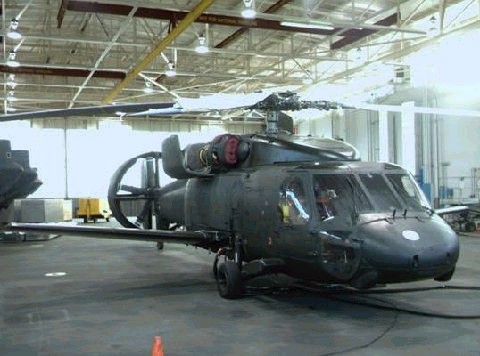
Proponents of compound helicopters are hopeful that the Defense Department will consider including these aircraft in the mix of rotary-wing military platforms. Compound helicopters have been around for at least 35 years, but have not caught on for various reasons. Advocates now believe that the time is right to reintroduce this technology, as a low-cost alternative to buying new helicopters and as a way to improve the speed and range of current helicopters.
A compound is a modified conventional helicopter that has an auxiliary propulsion system to provide additional thrust-beyond the thrust already produced by the rotors. The extra thrust helps unload the rotor in forward flight and increase forward speeds.
The only compound helicopter concept currently funded by the Defense Department is called the Vectored Thrust Ducted Propeller (VTDP). This compound helicopter is a modified Sikorsky H-60 airframe. A technology demonstration for the VTDP is under way at the Naval Air Systems Command, with funding from the Office of Naval Research.
The VTDP has fixed wings and a tail-mounted ducted propeller. It was designed by Piasecki Aircraft, in Essington, Penn.
The company's director of business development, John Piasecki, describes the VTDP as "an evolutionary step for the helicopter."
The tail-mounted ducted propeller, called the ring-tail, provides auxiliary thrust and control in forward flight, Piasecki explained. While a conventional helicopter gets all its lift and propulsion out of the main rotor, he said, "this tail helps to unload the main rotor from its propulsion responsibilities, because it can provide forward thrust, whereas the conventional tail rotor can't."
The VTDP also has fixed wings that work in concert with the tail to unload the rotor during lift. "By unloading the rotor from its lift and propulsion responsibilities, you can delay the onset of retreating blade stall, which limits the speed of helicopters," said Piasecki. The wings can fold and can be removed for stowage. [EDITOR: the wings need to ROTATE vertically in hover to not interfere with lifting power]
According to a Navair spokesperson, "the Navy is evaluating the VTDP/compound concept as a technology demonstration." Piasecki Aircraft received a $26.1 million contract in October 2000 to design, modify and test the VTDP technology on a YSH-60F aircraft.
Program officials involved in the demonstration declined to be interviewed. Through the Navair spokesperson, a program official said, "Results on the potential for the technology will be forthcoming after we complete analysis of flight test results in early 2005." Asked about the Navy's interest in this technology, the official said, "Piasecki Aircraft Company has designed a vectored thrust ducted propeller, which they claim has the potential for increased efficiency."
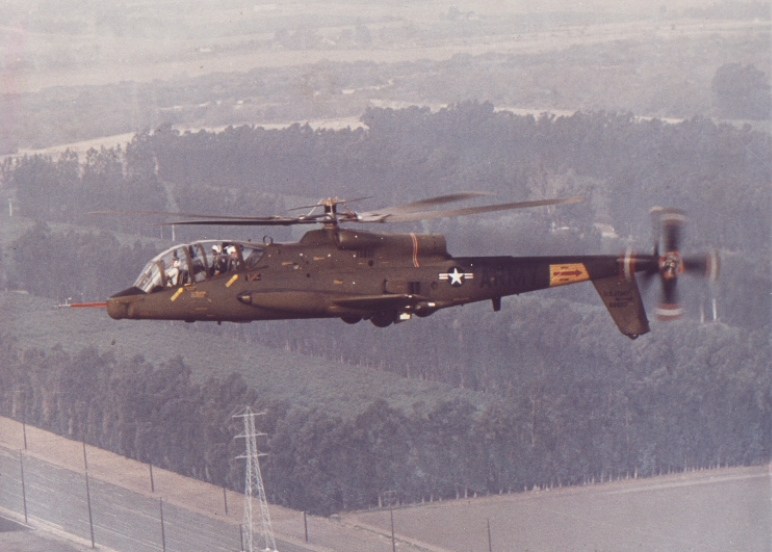
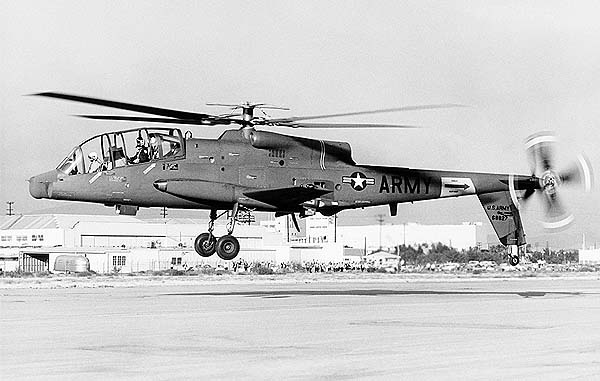
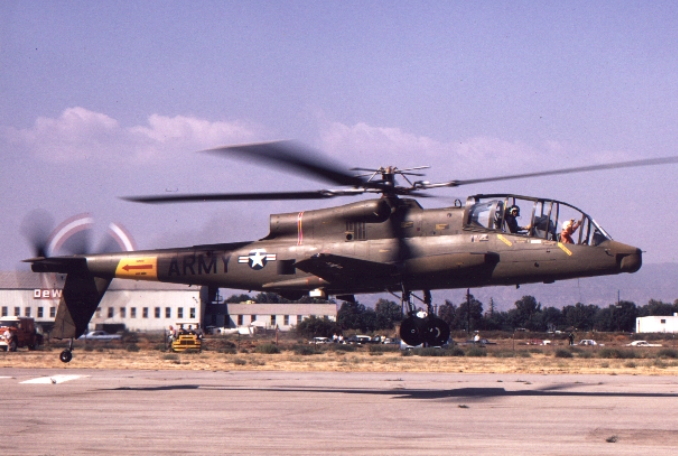
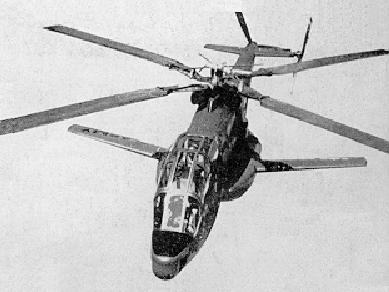
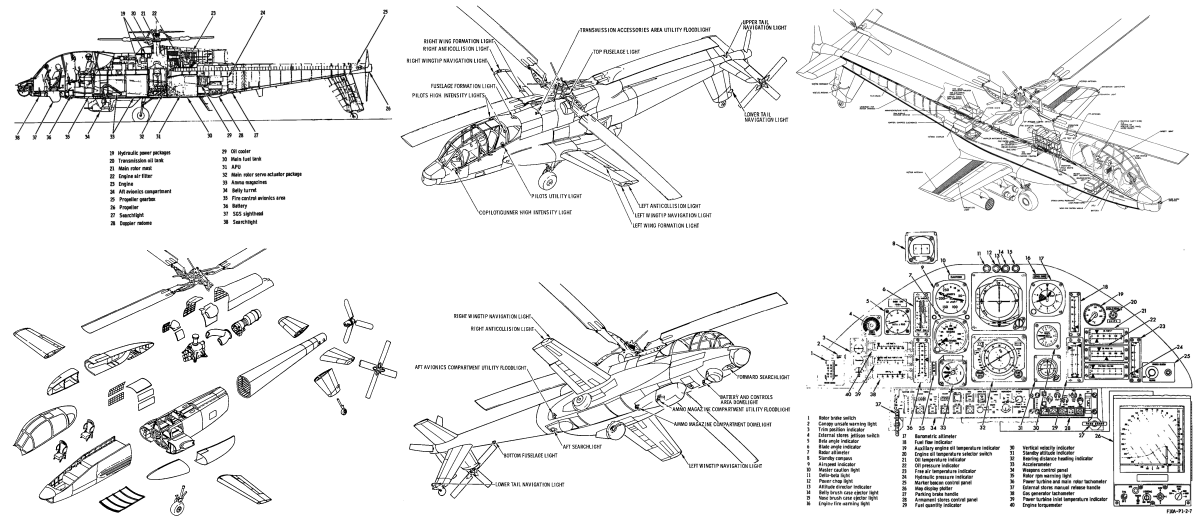
The closest the Defense Department came to buying compound helicopters was in the 1960s, when Lockheed built the AH-56 Cheyenne, which won a U.S. Army 1966 competition for an airborne fire support system. The company made 10 pre-production units and expected that the Army would ultimately order 375 aircraft. But the Army later decided to buy Cobra gunships and cancelled the Cheyenne procurement in 1969.
Piasecki said the Office of Naval Research had shown interest in the compound helicopter as an option for a Navy airborne mine-hunting platform.
To hunt mines, the helicopter has to tow a sensor. According to Piasecki, the extra weight, on many helicopters, can make the nose tip forward, "raising safety concerns." A compound, he said, "could provide more stability." But that capability has not yet been tested, he noted.
It appears, however, that the Navy now is not convinced that it needs a compound helicopter for the mine-hunting mission, said an official from the office of the defense secretary. He requested that he not be quoted by name. "They decided that the current helo [the MH-60S] can do that job and don't need the [compound] capability," he told National Defense.
Nevertheless, he added, "there is a broader need for this technology, other than for countermine operations." The ability of the compound aircraft to fly long distances at speeds of 230 knots makes the VTDP technology a viable option for upgrading the Army's BlackHawk fleet, for example, said the official. "There should be a broader basis than just countermine." Most conventional helicopters fly no faster than 140 knots.

The OSD official stressed that even though the military services abandoned the compound helicopter decades ago, it is worth considering its reintroduction, because the Defense Department needs to upgrade aging aircraft and does not have enough money to replace every outdated helicopter with a brand-new one.
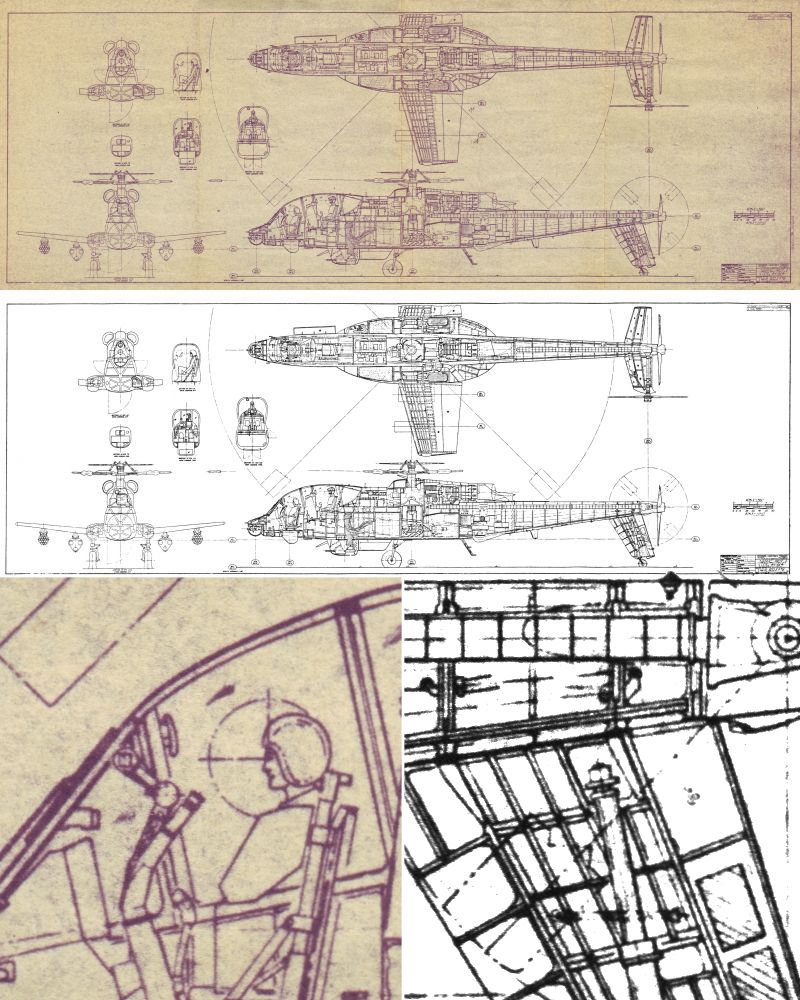
Joe Horn, a helicopter expert at Pennsylvania State University, said that the VTDP could provide a "low-cost alternative to the tilt-rotor." He noted that the additional weight of the compound creates problems in low-speed flying and hovering. "But it's viable for forward flight," when high speed is the top priority.
The Navair official noted that compound helicopters have "potential advantages in speed and range over conventional helicopters, but have disadvantages in hover, cost and complexity. A suitable application would be one in which the speed and range advantage outweighed the disadvantages."
Piasecki is hoping to interest the Army special operations forces in the compound helicopter, as an option to upgrade the MH-60 BlackHawk and the MH-47 Chinook.
The company, meanwhile, submitted a proposal to the U.S. Air Force to upgrade the H-60 for its combat search-and-rescue fleet. An analysis of alternatives by the Air Force, however, noted that the compound aircraft may not be ready on time to meet the desired schedule for the CSAR program.
PAST PRECEDENTS
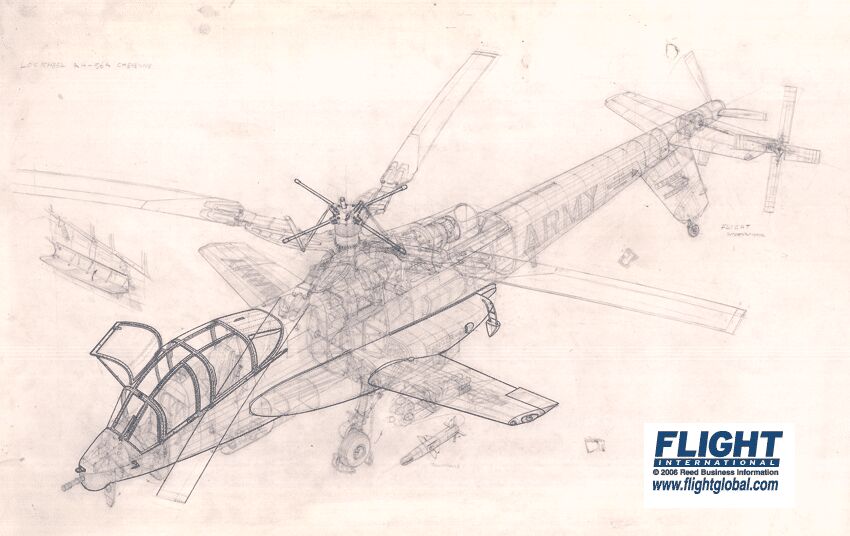


youtube.com/watch?v=nK48FcwcY7Q>
John Pike reports on his excellent Global Security web page on the AH-56:
The Lockheed AH-56A Cheyenne attack helicopter was designed to meet the U.S. Army's requirement for the Advance Aerial Fire Support System (AAFSS). The helicopter's mission would eventually be assumed by the Boeing (formerly McDonnell Douglas) AH-64 Series Apache attack helicopter. The AAFSS, which began in 1964, was won by the Lockheed AH-56A Cheyenne. Bell entered a scaled-down version of it's Iroquois Warrior. The other competitor was the Sikorsky (S-66) (1964) which looked similar to the AH-56A Cheyenne, but had a Rotorprop tail rotor which could rotate on it's axis throught 90° to act both as an anti-torque rotor or as a pusher, thereby transforming the S-66 into a compound aircraft in cruising flight.
The rigid-rotor Cheyenne, with a crew of two, featured a XM112 swiveling gunner's station linked to rotating belly and nose turrets, and a laser range-finder tied to a fire control computer. It was armed with an XM52 30mm automatic gun in the belly turret and a XM51 40mm grenade launcher or a XM53 7.62mm Gatling machine gun in the chin-turret, TOWs, and XM200 2.75 inch rocket launchers. The Cheyenne had a single rigid four-bladed main rotor and anti-torque tail rotor, and a three-bladed pusher. The Cheyenne was powered by one General Electric T64-GE-16 3435 shp turbine engine. The AH-56A had a maximum speed of 214 knots, cruise speed of 197 knots, a service ceiling of 26,000 feet, maximum range of 547 nautical miles, and could climb 3,420 feet per minute.
youtube.com/watch?v=4w85NNXAn_Y
Lockheed rolled-out the first prototype on May 3, 1967. Because of the advanced technologies in the AH-56 Cheyenne, the program ran into serious delays and cost overruns. Thus, Congress was severely critical of the program. However, advocates of the AH-56 Cheyenne argued that the program was about to succeed, but it would still take several years for this aircraft actually to go into the field and help Soldiers on-the-ground. Ten prototypes were completed before the program was terminated August 9, 1972 due to delayed development, rising costs, and the appearance of two competitive company-funded initiatives by Sikorsky and Bell. The Army wanted a smaller, more agile Advanced Attack Helicopter (AAH) with a less complicated fire control and navigation system.
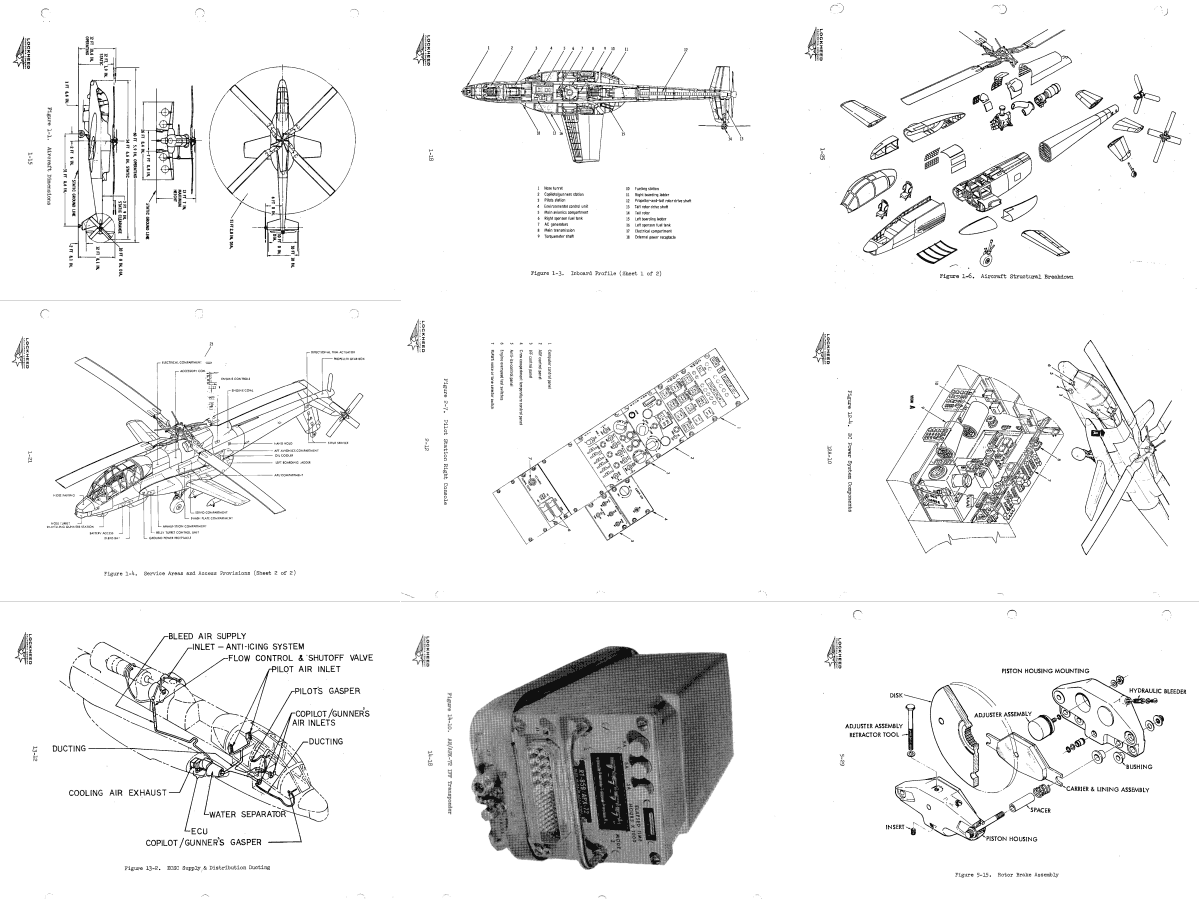
Another source reports:
Lockheed AH-56 Cheyenne First flight on Sept 21, 1967, the AH-56 was the winner of the U.S. Army 's 1965 AAFSS ( Advanced Aerial Fire Support System ) competition. By 1968, 10 pre-production units were delivered and others 375 units were approved, but meanwhile the Army acquired AH-1G Huey Cobras, a private-venture design of Bell. Finally, by the end of 1969, with Cobras already in Vietnam, the U.S. Army canceled the AH-56s request. Grown from the XH-51, was equipped with an additional pusher prop on the tail and had a max speed of 400 Km/h.
The Lockheed AH-56 Cheyenne attack helicopter was created in response to the U.S. Army's need for a fast, armoured and heavily armed helicopter to supplement the escort/attack role.
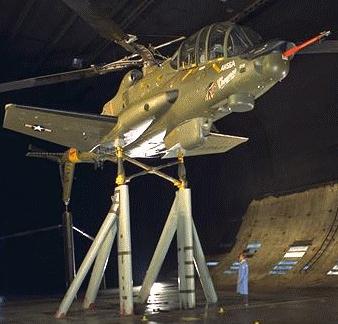
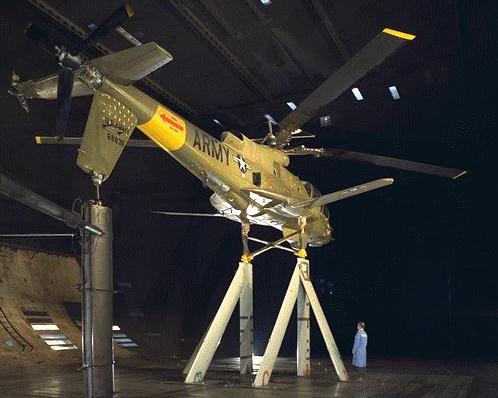
youtube.com/watch?v=jFD-1rI6sIE
youtube.com/watch?v=D5hql0Tn98s
youtube.com/watch?v=N2lTuLF40BI
youtube.com/watch?v=DG9fzf7LY1Y
The Cheyenne featured a revolutionary compound helicopter configuration as well as a gyro-controlled rigid-rotor and three-bladed pusher tail propeller as well as a 4-bladed anti-torque rotor. It had small wings attached to the side of the fuselage that could off-load the rotor during high speed flight. The helicopter was powered by a 4350 shp General Electric T64-GE-16 gas turbine engine derated to 3925shp. The Cheyenne could accommodate a crew of two sitting in tandem in the enclosed cockpit with the gunner co-pilot in front of the pilot on a gun platform which could swivel 360°. A second gun system was housed in a nose turret. 6 under-wing attachment points were used for missiles or rocket pods. The sophisticated weapon-sighting system included night-vision equipment and a helmet-gun sight.
The Cheyenne at first proved highly capable and in December 1967 the Army ordered a production batch of 375 Cheyennes. During further flight testing however there were three crashes. The helicopter proved unstable at high speeds in excess of 320km/h. After the third crash in 1969, when the main rotor collided with the fuselage, the production order was delayed. Further design modifications took place and by 1972 most of the Cheyennes' faults were cured--but the program was cancelled due to budgetary problems. There were 10 Cheyennes built.
Armed with a nose turret, with either a 7.62mm minigun or 30mm XM140 cannon, or a 40mm XM 129 grenade launcher, wing mounted TOW ATFGM missiles or 2.75mm rocket pods, the Cheyenne could cruise at 388kmh with a max speed of 407km/h. It had a rate of climb in excess of 1025m/min and a range of 1970km.
P. Allen; The Helicopter, 1996
The ambitious AH-56 Cheyenne helicopter, with which Lockheed hoped to establish a foothold in the rotary-wing sector, was in fact a disappointment for the Californian company. It featured a rigid main and tail rotor, which Lockheed had been researching since 1959 - a rigid rotor enables helicopters to perform genuine aerobatic maneuvers.
The AH-56A Cheyenne was driven by a General Electric T64 turbine delivering over 3400shp. It had a stub wing with an 8m span and an area of 24m2, attachment points for six underwing stores weighing 900kg each, a streamlined fuselage with a tandem cabin seating arrangement, retractable front landing gear units, a fixed tailwheel, a rigid four-blade anti-torque tail rotor and three-blade pusher propeller at the tip of the tail boom. However the Cheyenne was complicated and U.S. Army orders were cancelled and development suspended in 1972.
G. Apostolo; The Illustrated Encyclopedia of Helicopters, 1984
Developed as Lockheed's entry in the Army's Advanced Aerial Fire Support System (AAFSS) competition, the Cheyenne was a highly sophisticated compound rotorcraft whose design incorporated several features pioneered in Lockheed's earlier XH-51A. The Cheyenne was named winner of the AAFSS contest in March 1966, at which time Lockheed was awarded an Army contract for the production of ten YAH-56A prototypes. The first of these made its maiden flight in September 1967, and all 10 aircraft (serials 66-8826 through -8835) had been delivered to the Army for flight testing by July 1968. In January of that year the Army had placed an initial order for 375 production machines, and the ten prototypes were subsequently redesignated AH-56A in early 1969.
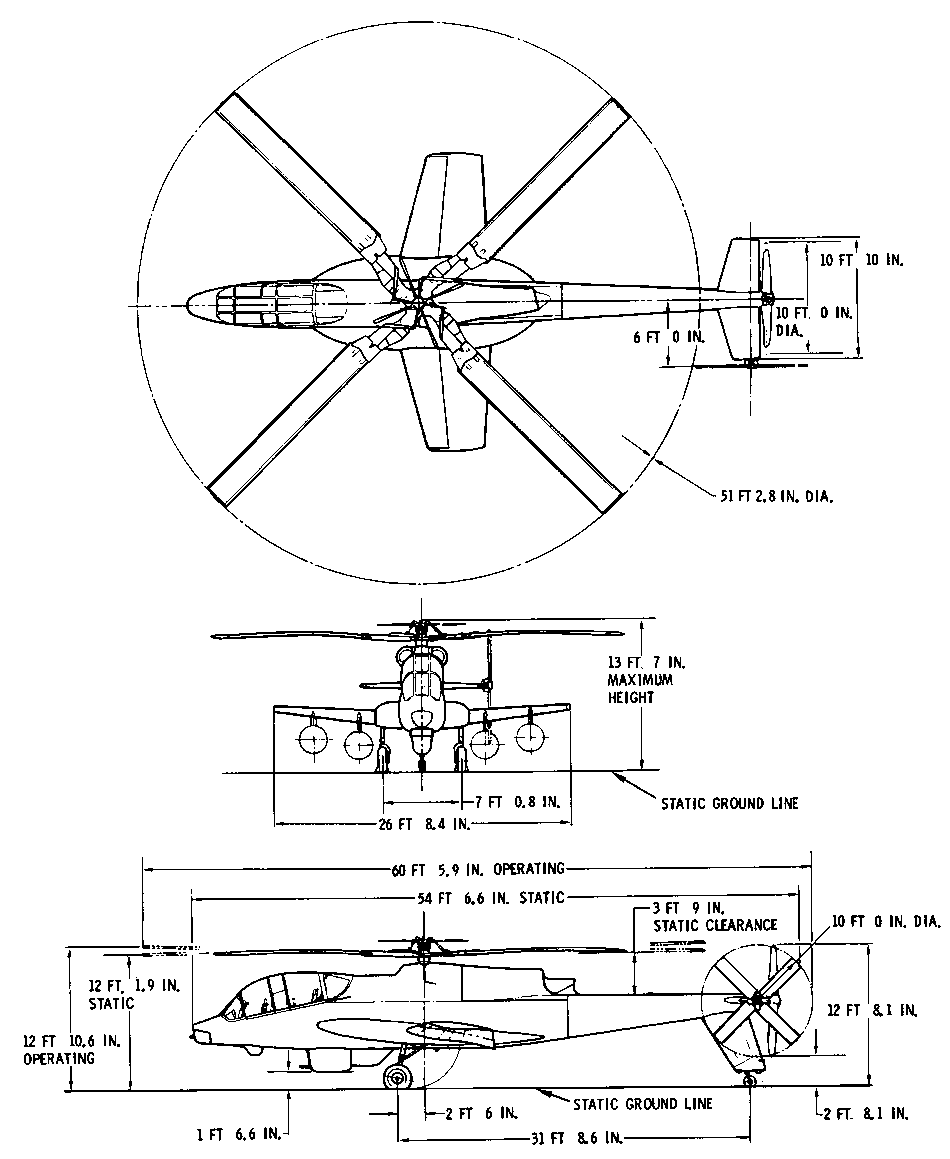
The Cheyenne was, to say the least, a rather exotic-looking aircraft. The forward end of its long and narrow fuselage was dominated by an outsized segmented canopy covering a tandem, 2-seat cockpit, while the tailboom supported a large ventral fin, a conventional anti-torque tail rotor, and a decidedly unconventional pusher propeller. A pair of small, low-set stub wings fixed to the fuselage sides contributed to the Cheyenne's hybrid look, as did its retractable, wheeled main landing gear. The AH-56A's ungainly appearance was deceptive, however, for in flight the craft was amazingly agile and extremely fast. The Cheyenne's impressive performance was the product of an innovative propulsion system built around a 3435shp General Electric shaft turbine engine. This powerplant drove a rigid, 4-bladed, gyro-stabilized main rotor, the tail-mounted anti-torque rotor, and the pusher propeller at the extreme end of the tailboom. During vertical and hovering flight all power was applied to the main and anti-torque rotors, while during forward flight all but about 700shp was shafted to the pusher propeller. In forward flight lift was generated by the stub wings and windmilling main rotor, and in absolutely 'clean' configuration the AH-56A was capable of sea-level speeds in excess of 400 kph!
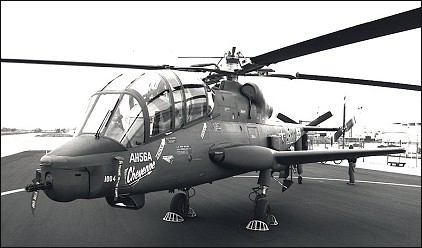
The Army's AAFSS specifications had called for an aircraft capable of undertaking armed escort, long-range interdiction, fire support, and anti-tank operations by day or night and in all weathers, and the Cheyenne had been armed and equipped accordingly. The AH-56A's armament consisted of a nose turret housing either an XM129 40mm automatic grenade launcher or XM134 7.62mm multi-barrelled minigun, a 30mm cannon mounted in a revolving belly turret, and an impressive number of TOW anti-tank missiles and/or pods of 2.75 inch unguided rockets carried on underwing hardpoints. The Cheyenne's day and night, all-weather flight capability was based on an extensive avionics suite which included automatic terrain-following radar, Doppler radar, an inertial navigation unit, and an automatic flight control system that allowed high-speed flight at altitudes as low as fifteen feet.
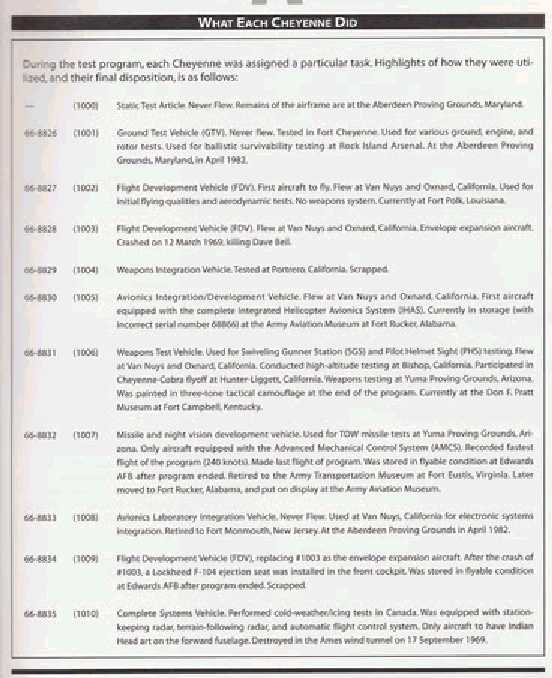
Despite its technological sophistication, or perhaps because of it, the AH-56A never entered regular Army service. The flight test programme revealed several significant problems with the aircraft's innovative propulsion system, problems which ultimately resulted in the fatal crash of one of the ten prototypes. In addition, by March 1979 significant cost overruns had increased the per-unit Cheyenne price by more than $500.000, an absurdly small increase that was unacceptable in light of the Army's continued high expenditures in support of operations in Vietnam. And, finally, the USAF had become increasingly vocal in its opposition to the Army's acquisition of an aircraft as capable as the Cheyenne, and continued to push for the cancellation of the AH-56 project, and cowards in the U.S. Army knuckled under to their non-sense. The Army ultimately decided to develop a cheaper, less capable and less sophisicated helicopter in place of the Cheyenne, and in August 1972 formally terminated the AH-56 program.
BUILD-A-MODEL:
#AA-2085 1/72 scale Lockheed AH-56A Cheyenne Attack helicopter to replace AH-1
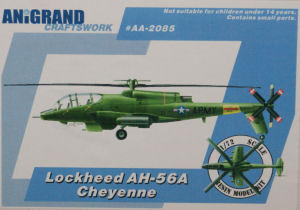
Model Kit Contents

Model Features
50 resin parts + Clear resin canopy & decal
Rotor dia. 217 mm
Length 231 mm
Unit price: U.S.$58
Shipping charge: U.S. $6.50
Each model kit contents 1 set of decal. Extra decals can also be ordered.
Extra decal US$1.50Anigrand Craftswork 1/72 AH-56A Cheyenne Kit First Look by Michael Benolkin:
"The kit fits nicely together and looks to be a straightforward build. Anigrand has also captured the unique pivoting gunner's seat that turned the gunner in the same direction as the turret."
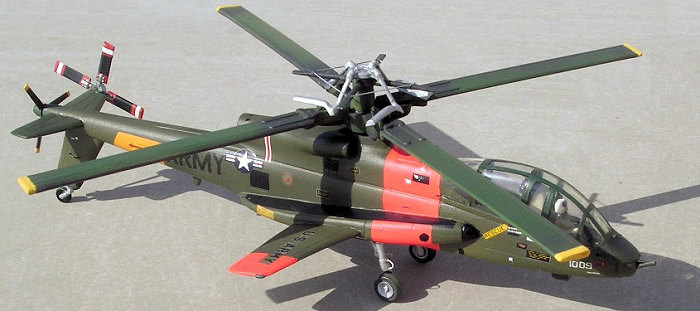
Aurora used to offer a plastic AH-56 model, but right now only the RESIN model from Anigrand and Legato are available.
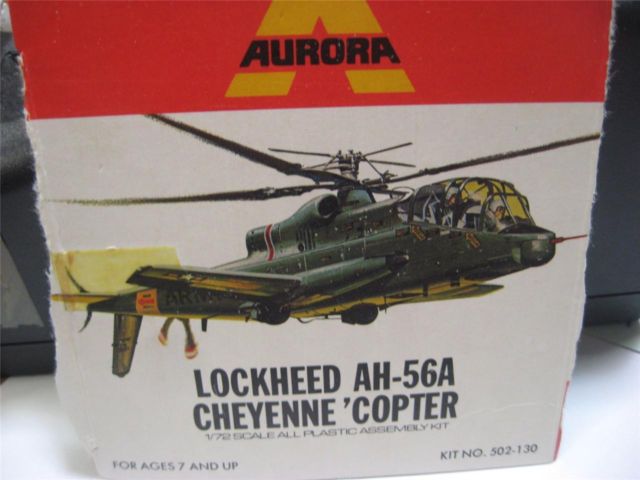
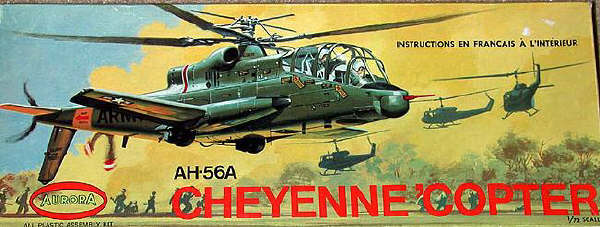
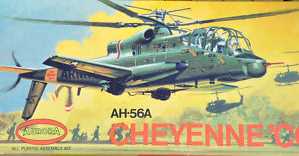
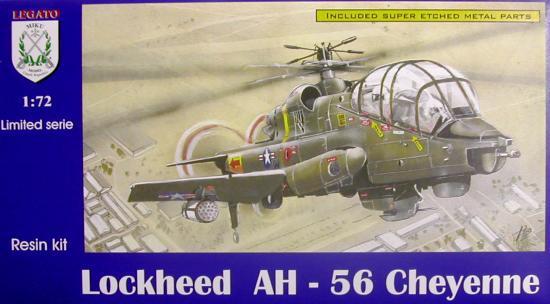
THE TRUTH: What Right Looks Like
AH-56 @ Fort Campbell, Kentucky

AH-56 @ Fort Rucker, Alabama:

Clearly, the 1947 National Security Act creating the separate service USAF and quasi-separate USMC has been a total disaster with the Air Farce SAYING it wants to do ALL aviation functions but is only really interested in doing sexy fighter-bombing to try to win wars by their firepower alone. This over-reaction to the 1943 North Africa USAAF troubles by centralizing ALL air power functions has left the U.S. Army without a tactical air force to support ground maneuver by fixed-wing observation/attack and transport planes since these things are neglected by the USAF. When General Gavin proposed the Army "Sky Cavalry" he expected the flimsy and slow helicopter to be only a interim stop-gap to work around USAF racketeering corruption until VTOL/ESTOL fixed-wing aircraft became available--not the rotten use of helicopters for 60 years that has cost us thousands of lives and $ BILLIONS of dollars.
4, 000 helicopters lost in Vietnam led the still-with-common sense Army to want replacements that fly much faster--in the 300 mph range. The AH-56 Cheyenne compound helicopter with fixed-wings and a pusher prop in the tail could fly over 100 mph faster than current type helicopters.
Being selfish racketeers, the USAF threw a temper tantrum when they saw fixed-wings on the AH-56 as if it was their God-given right to them and demanded Congress cancel the AH-56.
The USAF only accepted the A-10 in order to get the Cheyenne cancelled to spite the Army:
combatreform.org/A10TheWarthogAirForcetookittospitetheArmyfromCheyenneandCAS.pdf
When you break new ground problems arise, but most of the time they are solvable if the concept is sound (V-22 style tilt-rotors are not). Pilots are whiners not engineers; particularly Army/Mc rotorhead pilots who find any change in the status quo is "too hard".
Interservice Rivalry and Airpower in the Vietnam War, by Dr. Ian Horwood.
cgsc.army.mil/carl/download/csipubs/horwood.pdf
combatreform.org/horwood.pdfWhen asked what we would do for close air support (CAS), the USAF had to come up with a solution so they proposed the armored, fixed-wing AX "Stuka" that became the A-10 WartHog that is so successful-and thus hated by the USAF jet jocks.
combatreform.org/aircommandos.htm The moral of this story is to stick to your guns--unlike the Army rotorheads who wimped out after the AH-56 back-stab cancellation and kept on flying slow, loud helicopters even when presented with conservative NOTAR quiet helicopters
combatreform.com/killerbees.htm
...and now desperately needs to fly much faster if it wants any kind of survivable, organic, close air support for ground maneuver. Armored STOL crop-dusters like the Thrush Vigilante are off-the-shelf solutions now that should be acted on instead of throwing model plane UAVs at a 50% crash rate.
youtube.com/watch?v=cbanSkIk-xM
youtube.com/watch?v=R9grUNuOgYc
The needless deaths and maimed Soldiers over these decades demand this time the Army insists that it upgrades ALL of its helicopters with fixed-wings using Piasecki VTDP kits
youtube.com/watch?v=Yu2CwHwxJYA
...and tell the Air Farce to STFU since it ain't going to do the job--so stand out of the way of those than want to. To the Army rotorheads who think the status quo is AOK, they need to WTFU (wake the fu...) and stop marking no fly zones on maps before the whole sheet is redacted in black.
Want to know more?
Our book, Air-Mech-Strike: Asymmetric Maneuver Warfare for the 21st Century is now ONLINE for FREE:
http://books.google.com/books?id=RCWtHnYZ0LMC&pg
What Happened to the Original S-67 Blackhawk--Which was a Compound Helicopter?
S. Harding; U.S. Army Aircraft since 1947, 1990
Sikorsky S-66 and S-67: world's fastest helicopters--and ignored!
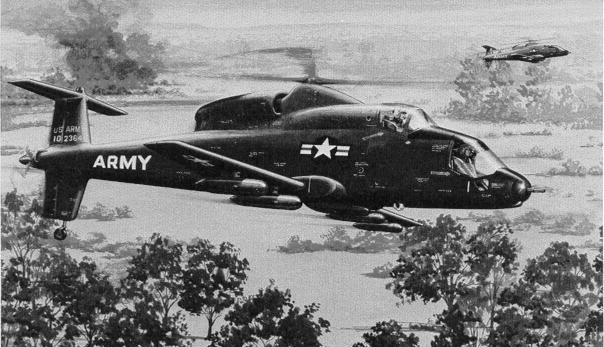
Sikorsky, who may rightly be considered one of the giants of the helicopter industry, has taken part in all the design competitions for combat helicopters held by the American armed forces. In 1964, it submitted the S-66 project to the U.S. Army for the AAFSS specification, calling for an aircraft with a maximum speed of approximately 418km/h and ten minutes' hovering capability.
The S-66 looked very much like the Lockheed AH-56A Cheyenne (which won the contest), but had a Rotorprop tail rotor which could rotate its axis through 90° to act both as a conventional anti-torque rotor in horizontal flight and as a pusher propeller, thereby transforming the S-66 into a compound aircraft in cruising flight.
G.Apostolo; The Illustrated Encyclopedia of Helicopters, 1984

Early artist's conception of the S-66

S-66 in action small
Here's the German version of a compound attack helicopter!
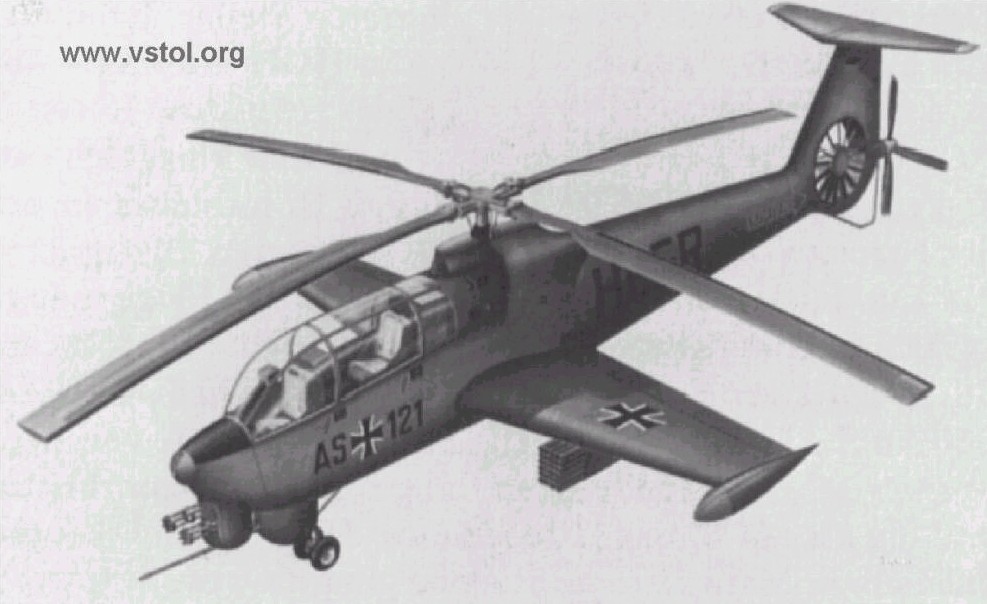
When the AH-56A was cancelled, Sikorsky first offered an intermediate aircraft, consisting of an armed version of the S-61, then designed a simplified AAFSS using the maximum number of components from the S-61. The result was the S-67 BlackHawk which appeared in 1970. Note that this "BlackHawk" attack helicopter predates the current Sikorsky BlackHawk UH-60 transport/attack helicopter.
youtube.com/watch?v=iniXBYFLybs
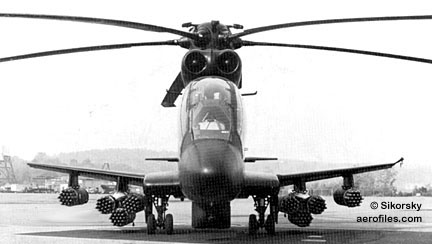
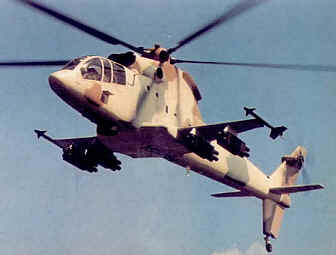
The BlackHawk looked like a helicopter with conventional rotors (those of the S-61) and had the now typical lines and features of a combat helicopter: two stub wings with a 8.33m span and an all-moving tail plane. The main-wheels were retractable, while the tailwheel was not. One of the most interesting features of this aircraft was the presence of speed brakes on the wing trailing edges, which could be used both as airbrakes and to improve manoeuvrability. In addition the main rotor blade tips were modified and given a sweep-back of 20°, to reduce vibration, stall speed and noise.
The BlackHawk was put through a long series of tests from 1970 to 1974 but judged unsatisfactory. It nonetheless established an E-1 class world speed record on 14 December 1970 by flying at 348.971km/h over 3km, beating this on 19 December with a new record of 335.485km/h over a 15/25km circuit. In the final stages of testing, the S-67 was fitted with night vision systems, a TAT-140 turret with a 30mm cannon and an insulated and soundproof compartment for troop transport. The S-67 was also designed to carry an armament of 16 x TOW antitank guided missiles, 2.75 in Hydra-70mm rockets or Sidewinder air-to-air missiles.
The BlackHawk demonstrated excellent maneuverability, weapon carrying capacity and versatility. At the end of the test cycle, the U.S. Army asked for the aircraft to be modified by substituting a ducted fan for the tail unit, and in this configuration it reached a speed of 370km/hour in a test dive in 1974.
MORE S-67 pictures:

3-view line art

Another view of S-67
The U.S. Army and marines are at fault for flying, slow, loud helicopters--industry has repeatedly offered faster helos with wings to unload the rotors and extra forward thrust. This video reminds us that the 220 mph S-67 Blackhawk attack helicopter was offered by Sikorsky as a less radical alternative than the Lockheed AH-56 Cheyenne program that was ruined by USAF back-stabbing.
The BlackHawk looked like a helicopter with conventional rotors (those of the S-61) and had the now typical lines and features of a combat helicopter: two stub wings with a 8.33m span and an all-moving tail plane. The main-wheels were retractable, while the tailwheel was not. One of the most interesting features of this aircraft was the presence of speed brakes on the wing trailing edges, which could be used both as airbrakes and to improve manoeuvrability. In addition the main rotor blade tips were modified and given a sweep-back of 20°, to reduce vibration, stall speed and noise.
The BlackHawk was put through a long series of tests from 1970 to 1974 but judged "unsatisfactory". It nonetheless established an E-1 class world speed record on 14 December 1970 by flying at 348.971km/h over 3km, beating this on 19 December with a new record of 335.485km/h over a 15/25km circuit. In the final stages of testing, the S-67 was fitted with night vision systems, a TAT-140 turret with a 30mm cannon and an insulated and sound-proof compartment for (6) troop transport. The S-67 was also designed to carry an armament of 16 x TOW antitank guided missiles, 2.75 in Hydra-70mm rockets or Sidewinder air-to-air missiles.
The BlackHawk demonstrated excellent maneuverability, weapon carrying capacity and versatility. At the end of the test cycle, the U.S. Army asked for the aircraft to be modified by substituting a ducted fan for the tail unit, and in this configuration it reached a speed of 370km/hour (230 mph) in a test dive in 1974. The U.S. Army rotarytards still fly exposed tail rotors that they walk into on the ground and is cause of 10% of all helicopter crashes by getting snagged on trees, wires, obstacles as well as a major source of noise that alerts enemies to shoot them down. The Hollywood helicopter that always explodes in a ball of fire is not far from the truth thanks to rotarytard stupidity and refusal to adapt to real world conditions.
One feature of the S-67 borrowed from the Russian Mi-24 Hind in addition to wings is that a 6-man recon or CSAR team could be fought into and out of enemy-held areas; a capability we still lack today.
Mi-24 Hind Troop Insertion
youtube.com/watch?v=Qxk42v1yP2k
Aircraft History and Specification
In 1964, U.S. Army lunched the AAFSS specification, that calling for an aircraft with a high-speed cruising and long-time hovering capability. Sikorsky submitted the S-66 pusher tail rotor project that competitor with Lockheed AH-56 Cheyenne. The AH-56 won the contest but failed to meet the expectations. For intended to replace the AH-56, Sikorsky self-venture developed a simplified AAFSS that used a number of existing components to complete the S-67 Blackhawk. It was not only designed as a attack helicopter, but also served for other missions as troop transport, armed rescue and anti-submarine warfare. Sikorsky proposed the S-67 to U.S. Army as the AH-3 and later for the new AAH competition but never chosen for the fly-off. Flight test started by Sikorsky's test pilots in 1970, it established helicopter world speed record 220.89 mph in the same year. In 1971, U.S. Army joined the evaluation program but it was judged unsatisfactory to meet the new competition. S-67 was finally destroyed in crash at 1974 Farnborough air show.
Type: Muti-role attack helicopter
Purpose: To demonstrate a true air-superiority combat maneuvering attack helicopter
Span: 27 feet.
Length: 64 feet. 9 inch.
Height: 15 feet.
Rotor dia.: 62 feet.
Engine: 2 x General Electric T58-GE-5 turboshaft
Max.speed: 220 mph
Crew: 2
Armament: 1 x 20mm M61A1 Gatling or 30mm autocannon4 x M216-19 tubes 2.75" inch (Hydra-70mm) rockets
2 x AIM-9 Sidewinder missile
One area where Army pilot whining is needed but not heard is for crew escape. There's NO EXCUSE why at least bail-out parachutes are not worn NOW by everyone in Army helicopters and why after all these years an attack helicopter ejection seat or capsule hasn't been fielded when the Russians already have such things in service. So much for American "leadership" in military aviation; held back by rotarytards.
youtube.com/watch?v=NtB-XKFxEJY
Another capability understood by industry but apparently not rotarytards is CAMOUFLAGE: notice the excellent tan desert camouflage of the S-67 in the video and still pics on the web page below:
Sikorsky took steps to make their S-67 so quiet that you wouldn't hear it until it was 500 meters away--too late if in a combat situation. Its no surprise industry today (the MICC-TT) offers the military junk--the military WANTS junk--not excellent war equipment. The U.S. miltary's worst enemy is itself.
BUILD-A-MODEL:
Want to build a 1:72 scale model of the S-67 BlackHawk?
#AA-2022 1/72 scale Sikorsky S-67 BlackHawk High speed gunship proposal to be AH-3
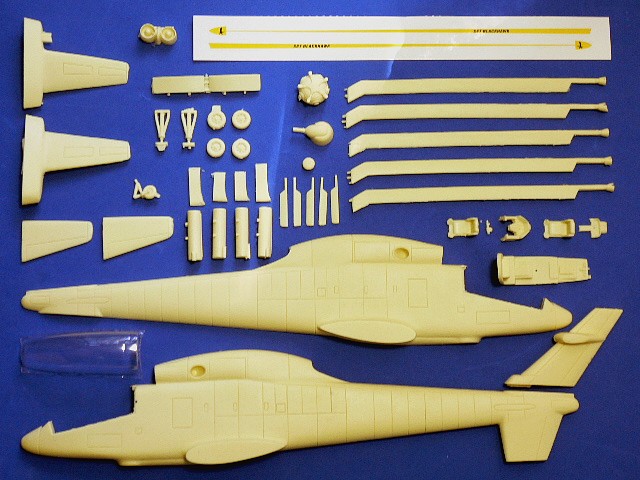
Model Kit Contents
Model Features
45 resin parts + Clear-resin canopy & DecalRotor dia. 262 mm
Length 274 mm
Unit price: U.S.$48
Shipping charge: U.S.$6?Each model kit contents 1 set of decal. Extra decals can also be ordered.
Extra decal
U.S. $0.20
PIASECKI SHOWS THE WAY!

Piasecki 16H1 "Pathfinder I"Had the Cheyenne used Piasecki's simpler flight arrangements a happier outcome would have taken place. With today's rotor technologies compound helicopters are ready to lead the way into the 21st century by upgrading existing helicopters to enhanced capabilities.

The Piasecki Pathfinder II compound helicopter exceeded 200 mph in the 1960s!
This technology is proven and safe!
The Pathfinder was an interesting Compound Helicopter concept that was carried out during the 1960s by Piasecki Aircraft. There was interest from both the Army and Navy who shared a joint development contract.
The Compound Pathfinder used a standard helicopter-style overhead rotor which was off-loaded by a small low-mounted fixed wing when the craft transitioned to high-speed horizontal flight. The three-bladed rotor was mounted on a streamlined pylon which was powered by turbine engine. The small tapered low wing was equipped with standard flaps. To the rear of the fuselage were cruciform fins which supported an annulus which contained a propeller. That rear installation performed the function of anti-torque and directional control. The model also mounted a retractable landing gear carriage.
In operation, the Pathfinder took off like a standard helicopter. Acceleration was then achieved by directing power from the rotor into the rear propeller, then as the speed increased, the fixed wings took on a larger share of the lift. It should also be noted that the Pathfinder could also be used in a STOL mode, which greatly increased its payload capability. The reverse transition for landing exactly reversed the take-off process.
There were actually two versions of the Pathfinder, the first of which was the -1 version, which first flew in 1962. The similar Pathfinder II, the 16H-1A, was completed in 1965.
The 37 foot long privately-developed Piasecki 16H-1 weighed 11,000 lb and had a wingspan of 20 ft. The five-seat Pathfinder I was originally powered by a 550 hp Pratt & Whitney PT6B-2 turboshaft engine. The engine powered a 41 foot fully articulated three-bladed rotor and a 5.5 ft three-bladed ducted propeller in the tail (called a "ring-tail") to provide forward thrust and directional and anti-torque control with four vertical vanes in the duct. Gross weight was 2,611 lb and fuselage length was 25 foot. The 16H-1 made its first flight on 21 February 1962. Overall, the Pathfinder I had the handling qualities of a conventional helicopter, but used its wings and pusher propeller to off-load the rotor and increase its maximum forward velocity to 148 kt. 185 flight hours were accumulated before May 1964, when Piasecki was contracted to test a high speed modification, the 16H-1A Pathfinder II. It was equipped with a 1,250 shp T58 turboshaft engine, a new drive system and propeller to handle the increased power. The rotor size was increased to 44 foot diameter, and the fuselage was stretched to accommodate eight seats. Flight testing resumed on 15 November 1965 and it accrued over 40 hours in the air by May 1966, reaching speeds of 195 kt. Later, it was redesignated the 16H-1C when the engine was upgraded to a 1,500 shp T58-GE-5.
The -1A version was considerably larger than the initial prototype, with a three-foot bigger diameter rotor at 13.4m, and its maximum speed was much faster at 360km/h, compared to 287 with the first version. The gross weight of the 1A model was 1037kg heavier than the first model. The two models used different powerplants; the first used a United Aircraft of Canada PT6B engine, while the later version used a General Electric T58 turbine engine.
S. Markman & B.Holder, Straight Up: A History of Vertical Flight, 2000
G. Apostolo; The Illustrated Encyclopedia of Helicopters, 1984
Beginning in early 1964 the Army and Navy jointly funded modifications to Piasecki Aircraft's Model 16H-1 Pathfinder compound research helicopter as part of an ongoing study of advanced high-speed rotorcraft technology. The 16H-1 had originally been developed as a company private venture and, as such, had first flown in February 1962. The modified version, designated the 16H-1A Pathfinder I by Piasecki, made its first tethered test ascents in October 1965.
Like its predecessor, the Pathfinder II was a high-speed compound rotorcraft which utilized a conventional fully articulated, three-bladed main rotor for vertical lift and a tail-mounted, dueled "ringtail" pusher propeller for directional and anti-torque control. After takeoff, power was applied to the pusher propeller for forward propulsion, and in cruising flight the craft's small wings helped off-load the rotor and increase forward speeds.
The Pathfinder II differed from the earlier 16H-1 primarily in having a more powerful General Electric T58 shaft turbine engine, a longer and more streamlined fuselage with increased cabin accommodation, a larger main rotor, increased-span stub wings, strengthened main landing gear, redesigned engine air intakes, and upgraded electronics.
The Pathfinder III made its first free flight in November 1965, and quickly proved itself to be an extraordinarily fast and maneuverable machine. Forward speeds in excess of 360 kph were not uncommon, and the 16H-1A was capable of flying backwards and sideways at speeds of up to 55kph. The evaluation programme provided a wealth of valuable information on compound rotorcraft technology and operations, much of which was later used in the development and testing of the AH-56 Cheyenne. Joint Army-Navy sponsorship of the 16H-1A ended in late 1966, at which time the craft was returned to Piasecki for further company-funded research.
S. Harding; U.S. Army Aircraft since 1947, 1990
THE XV-1: TOO FAST FOR SLOW MINDS?
Its clear today that the overly complex, powered rotor helicopter of Igor Sikorsky became ensconced by President Roosevelt's brilliant ordering of the U.S. Navy to obtain 100 small aircraft carriers made from cargo ships and to have helicopters capable of doing anti-submarine warfare (ASW) onboard to defeat German U-boats and Japanese submarines. However, as a liberal Democrat, the political "pork" of the northeast where Sikorsky, Bell, Piasecki and Vertol made complex powered helicopters strangled simpler helicopters that could indeed go faster at less costs and maintenance headaches. James McDonnell in Missouri offered many improved simpler rotor-tip drive, transmission-less, helicopters only to have them rejected for military service by racketeering political forces. The legacy of this corruption is our troops have been damned to slow (under 150 mph), noisy helicopters easy to shoot down and cannot fly often to do maneuver air support (MAS) and far enough to do long-range Air-Mech-Strike 3D air-ground maneuver. For a history of McDonnell's helicopters click on the link below:
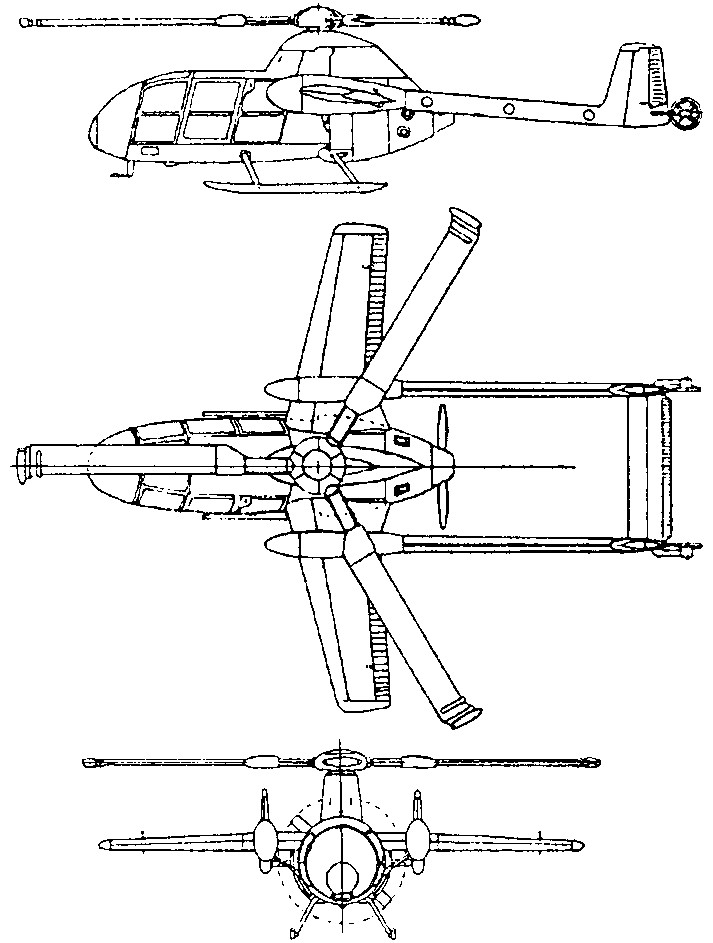
The McDonnell XV-1 could go 200+ mph in the Korean war era yet the U.S. military-industrial complex would rather sell our troops conventional helicopters that fly slower and get them shot down to be killed, wounded or captured! Establishment histories complain that the XV-1 was piston-engined but the defeatist Army didn't even bother to see what it could do with a gas turbine engine.
combatreform.org/MAChelicopters.pdf WHY NOT SpeedLittleBirds?

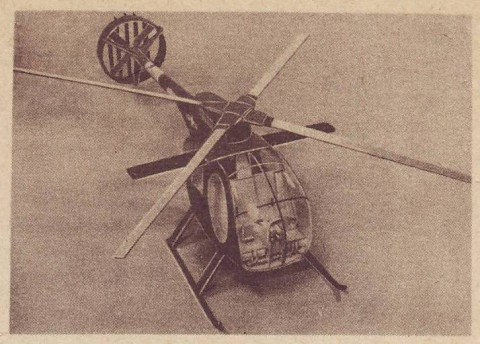
Maybe the way forward is to start SMALL with the Light Observation Helicopters (LOH) the U.S. Army Operates?
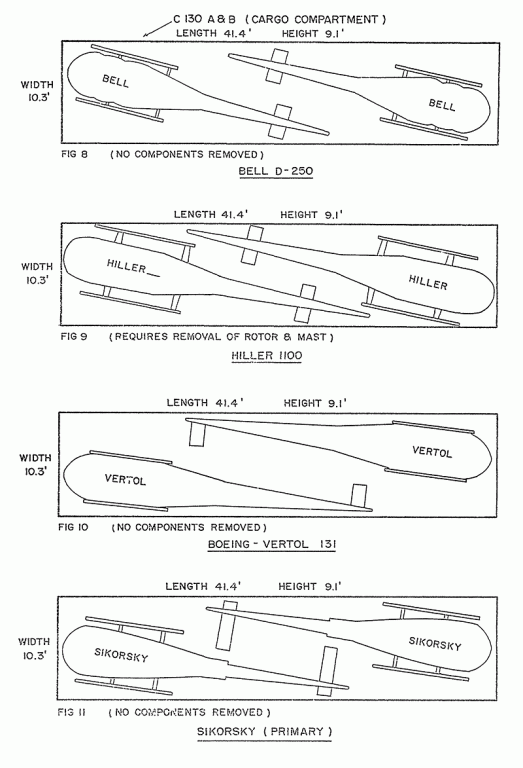
One company advocates adding ducted fans and a new co-axial rotor system...the Russians have had these for YEARS...we are only now just catching up?
youtube.com/watch?v=RVWsokh8vT4
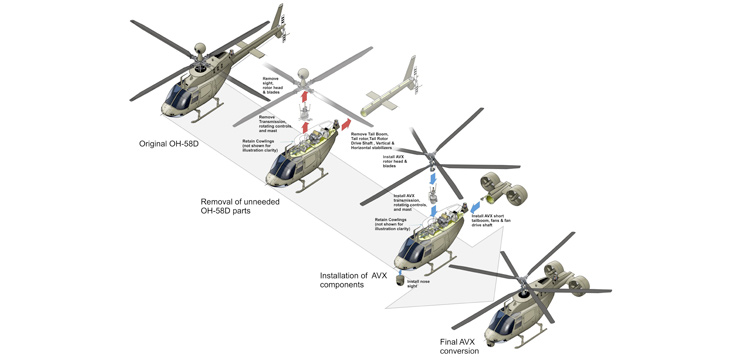
The Brantley scout helicopter was considered "too small" by the Army back in the '60s. It wasn't too small to be flown by the big-breasted, fiery red-haired Karin Dor playing Helga Brandt in the James Bond 007 movie, "You Only Live Twice"


But she sadly didn't engage in OH-13 Bell Model 47G helicopter vs. Killer Bee autogyro combat with Sean Connery in Little Nellie.
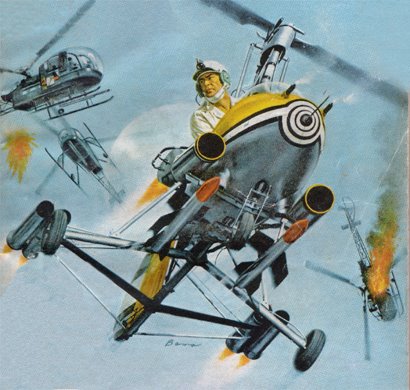
A recent DEFENSE NEWS article points out the vulnerability of French Gazelle helicopters they were able to air transport to Mali and how they were only able to pull the intervention off because they still keep a string of bases in the region.
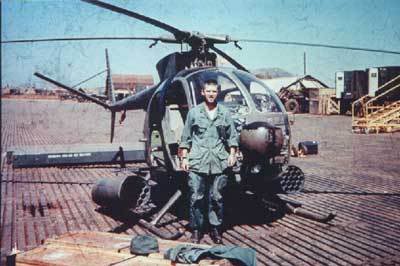
Our points are that we CAN have Killer Bees that are bullet-proof without turning them into bloated AH-64s that are hard-to-air-deploy. Moreover, these Killer Bees need to fly FASTER so they are not hit by enemy fire in the first place. There is no reason why even a small turbine-engined observation/attack helicopter cannot have lightweight ceramic armor protective against enemy AKM 7.62mm Soviet short cartridge fire. Even better, fixed-wing Killer Bees with belly cannon do not have to dive onto their targets and can strafe enemies from safe angles.
Killer Bees MORE FUTURE CONCEPTS

"Compounding" large helicopters can improve their speeds and ranges so they can self-deploy and not have to be dismantled and stuffed inside fixed-wing transports. Moreover, if the U.S. became smart we would operate at least one Mobile Off-Shore Base (MOB) in the Indian ocean to get our troops off foreign soil and stop throwing $BILLIONS away on USN aircraft carriers that operate worthless F/A-18 fighter-bombers and amphibious carriers carrying low-skilled marines and their slow helicopters that drop them off to foot-slog without light tanks and fight third world gunmen M16 versus AK47 & RPG even--or from undermatch.
Clearly, the U.S. Army should ring-tail its existing AH/MH-6, OH-58D, UH-60, AH-64 and CH-47 helicopters to meet the increased speed and range demands of the 21st Century. Below is just one way it could be done for the venerable Chinook (also a Frank Piasecki creation!):
Retired U.S. Army LTC Charles Jarnot's Compound CH-47G "Speed Chinook"
Self-Deployable CH-47Gs!
slideshare.net/1st_TSG_Airborne/speedhook-v10
FEEDBACK!

PUBLIC:
Combat Reform: A Commitment to Military Excellence
PRIVATE: itsg@hotmail.com
A helicopter pilot asks if the CH-53 could be made into a "Speed Stallion" compound helicopter:
"Sir,
Is there any feasiblity in doing a modification to a Sikorsky CH-53E to make it a compound helo?
They are considering a SLEP/Upgrade to the 53 in the next few years, it is not scheduled to be replaced by the V-22, and significant increases in range/speed would give the community much more capability in comparison to other platforms. The obstacles I see with putting wings and VTDP are the heavy gross weights involved (40000-80000 lbs), high torque produced by the rotor head when heavily loaded in a hover (engines produce around 14000 SHP), and the configuration for folding the aircraft and operating from amphibious assault ships. Is this compound technology only feasible for smaller, lighter helos, or would it work on a heavy lift transport like the CH-53E? Any response would be appreciated.
[The CH-53E is a three-engine assault transport helicopter, designed for transport of heavy cargo and troops over long distances, with a capability to aerial refuel, carry external loads up to 36000 lbs, operate in austere environments, etc. The main rotor disc is tilted forward 5 degrees and consists of seven blades. MR diameter is about 80'. The tail rotor is tilted 20 degrees down to provide additional lift/balance torque forces and longitudinal pitch]."
Piasecki replies:
"The answer is yes a MH-53E or X could be made into a compound.
The mods as you indicate would be significant....as will be the "X" upgrade.
The real killer of the 53E is its drag which while it has lots of power can not do much else with it that lift or climb.
Yes its fast ##### 170 or so kts yet it gets their using lots of power.
A 53X with folding wings on sponsons a VTDP between 11 and 15 feet in diameter and a way cleaned up engine inlet/pod area is not unfeasible. If the idea is to make a new airframe around the 53X dynamics it is easy to adapt the compound features yet if its just the old new radio an engine upgrade then the job becomes more difficult.
PiAC has do some work on your concept in the 1973 time frame and I will check to see if we have drawings.
I will send you a scan so you can get a look at what is involved. Thanks for your interest."
Fred Piasecki
VP Engineering
Piasecki Aircraft Corp.
(610) 521-5700 x107
(610) 304-6689
piasecki_fw@piasecki.comOur chopper pilot replies:
"Mr Piasecki,
The current SLEP for the CH-53E is an engine upgrade, a rotor head replacement, an electrical blade fold system, and a new avionics/cockpit package, with total cost being around $21 million per airframe, with 110 being thrown around as the probable number of planes they're going to keep around. We will still have all the same maintenance and age-related problems, and those birds will get tired and beaten up very quickly, because with the V-22 delayed as much as it has been, the 46's aren't going to take up the slack, and the newer/SLEP'd 53's would be called upon to provide 70-80% of the lift for the service. That's a pretty poor plan for $21 million per airframe.
An entirely new platform would cost more, but would yield a whole lot more in terms of performance, and I think that's where your company could really sell itself to the marine corps. If you could give it the ability to do external lifts with up to 40000 lbs, in high/hot/humid conditions, with an airspeed of between 180 (slow cruise)-280(max) knots and about 4-5 hours of fuel, you would have a platform that mates up well with the V-22 in terms of speed and range, but also has that heavy lift capability. It would also have to maintain capability to operate from Navy ships (LHA/LHD's), and show significant ability in hovering, low/slow environment, which is where the V-22 falls short. If we maintain our self-defense (door/ramp guns), our ability to TERF (flying in the terrain to mask our radar/IR signature), and our external load performance (particularly artillery), then you have a fail safe platform, that maintains all current performance characteristics and increases performance in key areas Sikorsky would be a strong ally in selling the concept, because they have proven platforms serving with the marines right now. Bell/Boeing already has the contract for the new Cobras and Hueys. By designing a new airframe, you could eliminate the drag/engineering problems that even an upgraded 53 will still have, and incorporate all the latest advancements.
Respectfully,"
Retired U.S. Army LTC Chuck Jarnot has also proposed a ring-tail CH-53X "Speed Stallion" for use as an Army Future Transport Rotorcraft (renamed Joint Heavy Lift helicopter) to replace the Chinook described in his book, "Air-Mech-Strike: Full-Spectrum Maneuver Warfare to Dominate the 21st Century, 1st Edition and on the following web page:
Next Chinook?
